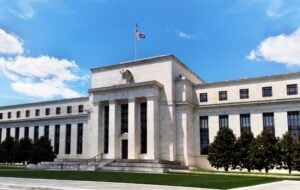Ronald Coase, a Nobel Prize–winning (1991) economist, was best known as a scholar who asked a simple question and then spent decades trying to give an ever-deeper answer.
The question was simple: why do we see the particular arrangements that appear in the economic world, rather than other arrangements? And the answer was also simple, though that simplicity was and is deceptive. The answer is “transaction costs.”
In my book Tomorrow 3.0 (Cambridge, 2018), I claimed that all costs are transaction costs, at least to the consumer. If we divide transaction costs into triangulation (buyers and sellers finding each other, agreeing on a price, and making an agreement), transfer (arranging for delivery, and making payment), and trust (ensuring that the product, the payment, and the parties are all safe from fraud or theft), that suggests that transactions are quite expensive. But of course that was Coase’s point all along, beginning with his 1937 article, “The Theory of the Firm”: using markets is expensive.
In the early 1930s, Coase toured the U.S. and parts of Europe, asking the same question of anyone who would sit still long enough to listen. The question was: “If markets are so great, why are there firms?” After all, workers don’t come home at the end of a long day and complain, “Man, prices were ordering me around a lot today.” Instead, everyone complains about their boss. Even bosses complain about their bosses.
In an economics class, students learn about how prices direct people in a market economy. But in the real world, most people work in little “command economies” called firms. The reason is that the transaction costs of using markets are high. Imagine that a worker on an assembly line puts some bolts into an auto chassis. She doesn’t then go look for a buyer for that partial car, or sell the thing on eBay. Instead, the assembly line just moves the chassis on to the next worker, who adds a fender. And so on, worker after worker, task after task, until the car is ready to be sold.
Prices Matter
Prices matter, of course. The price of the car will likely determine how many such cars are sold, and how quickly. The comparison of price to the cost of making the car registers as profit or loss, and signals to other producers whether they should ramp up their own car-making activities. But firms mostly operate internally using hierarchy and command.
Coase noticed that this margin, the point where it is cheaper to use the market than to use a firm to internalize the costs of organizing a transaction, is highly variable. The size of the firm, then, depends crucially on the cost of using the market.
Every firm faces what we now think of as the “make or buy” decision. An auto company may own the steel company that supplies the metal used to make the cars. It probably does not own the iron mine where the ore to make the steel is dug out. And almost certainly, the auto company does not own the wheat farm where the grain used to make bread for sandwiches in the employee cafeteria is grown. If it is cheaper to buy, the firm shrinks; if it is cheaper to make, the firm grows.
Much of the cost of using the market and price mechanism is transaction costs. You have to be able to find, obtain, and reliably depend on the quality of what you can buy, if you decide not to make that item yourself.
That raises the question of whether there have to be firms at all, if transaction costs fall far enough. I explored that idea in an essay titled “Bosses Don’t Wear Bunny Slippers.” In that account, the bosses discover that they can’t rely on outside contracts alone, and need some employees.
But I wrote that 10 years ago. In 2008, Sears was still a reasonably strong company, and Amazon mostly sold books. In 2018, buying almost anything and making or selling only your core product at least seems possible.
Will large, vertically integrated firms as we have known them disappear?
“Vertically integrated” means owning some of the “upstream” supply chain or some of the “downstream” retail space where consumers actually buy things. That control over the supply chain, and the consequent cost saving, was actually the explanation for the growth of the integrated big-box stores, most particularly Sears in the early 20th century, and Walmart, Best Buy, and Barnes and Noble in the late 20th and early 21st centuries.
Being able to buy in large quantities and guarantee an output market for small producers was an excellent way to bring down transaction costs of finding products to sell, and the big-box stores could sell at a lower final price as a result. They drove many smaller firms out of business because their supply-chain dominance was unstoppable.
But, as economist Herbert Stein famously observed, “If something cannot go on forever, it will stop.” The new “platform economy” is built around using apps to sell reductions in transaction costs, enabling peer-to-peer transactions and sharing of many products. Sears and Barnes and Noble have for all practical purposes disappeared as viable enterprises. Best Buy and Walmart are both surviving, but they are doing that at least in part by expanding their online presence, becoming more like Amazon.
One big expense for retailers is a brick-and-mortar location where consumers can “interact with” (usually, but not always, meaning “try on”) merchandise. The problem is that a new store location or a new product may generate attention and foot traffic for a few weeks, only for the retailer to see the interest die down quickly. This has led to a number of large commercial spaces — especially, but not only, shopping malls — to encourage “pop-up” stores.
Malls need to cover their average costs, on average, but many times of the year they are happy to cover their marginal costs with short-term leases if the alternative is for the space simply to be vacant. After all, foot traffic and the visual appeal of colorful signs and interesting displays make all the other stores look a little less drab. As Melissa Wylie put it in the November 2017 Bizwomen:
Pop-up stores allow online brands to interact with shoppers and reach new people without breaking the bank on a retail lease, TechCrunch reports. Simon Malls recently launched The Edit to give e-commerce startups a place to set up shop, and to attract shoppers looking for fresh retail options.
Simon, which operates more than 300 malls in the U.S., opened The Edit’s first location last week at Roosevelt Field shopping mall in New York, TechCrunch reported. The Edit provides a pop-up retail space on a one- to six-month basis.
The Edit offers fixtures and displays, security, marketing and background music for as little as $500 a month, per TechCrunch. Brands now showing at Roosevelt Field include Beltology, Thursday Boot Co. and donut shop Cuzin’s Duzin.
This can all get pretty meta. “The Edit” at Long Island’s Roosevelt Field mall, which Wylie refers to in the article, styles itself as “a curated space for revolving brands, products & trends ready to shop, share & experience.” Thus, The Edit rents a relatively large space, giving the mall a reliable source of revenue. Then The Edit provides the retail equivalent of WeWork, only instead of a work desk and printer the user rents display space and a cash register. A few weeks of physical display and retail location and the current “tenant” moves out, having spent only a few hundred dollars, increased its brand recognition, and risked very little.
By renting rather than owning retail space, and ensuring that there is always something different and interesting to see, The Edit hopes to make evanescence a permanent feature. The Edit presents itself as the “first scalable turnkey retail platform.” The firms that use The Edit space can have far fewer employees, and a far smaller footprint, because they only rent, and briefly at that, their consumer-facing physical space. You can imagine that six firms use just one physical retail space over the course of a year, taking turns using the space for two months each.
Why Not Rent?
Which is why I think that if Coase were alive today, he would ask a different question: why do so many firms own, when they could rent? The answer, though, would be the same: transaction costs. But as new forms and platforms are created, we see a dramatic decline in firm size and the physical presence of retailers. Those empty Sears, Penny’s, and other large retailer stores at your local mall may soon be repurposed as flexible retail platforms where online sellers can let people interact with their products at very low cost. Firms may become dramatically smaller, as other systems for controlling transaction costs replace them. Stores will act like miniature malls, renting space, not selling products.
Richard Sears was originally a railroad man; he vertically integrated into retail through his famous Sears Catalogue as a way to ensure business for his railroad. Later, the company paid a fortune for retail space, which it owned and operated at a high volume.
We are moving back toward a “catalogue” setting, where people can find things online. But folks still want to touch, to feel, and to try on. Renting space and sharing it with other retailers in a “curated” setting is not really new. It’s just a different way of reducing transaction costs.





